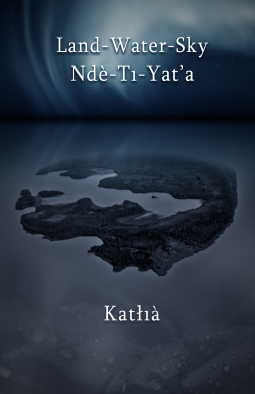The Medicine Man brought Mǫzhįą on a spiritual journey that led them far beyond the valley. As they travelled, the Medicine Man told Mǫzhįą many stories of the land, water and sky legends that had existed from time immemorial. All the while the Medicine Man gave offerings to the land and water in return. It took three days for the Medicine Man to tell Mǫzhįą what he needed to know. By the time the Medicine Man fell silent, they had reached their destination, a large island at the tip of the north arm of the great lake.
Land-Water-Sky/Ndè-Tı-Yat’a is the debut novel from Dene author Katłįà, and as she writes in her Acknowledgments at the end of this book, her inspiration was to honour her people's tradition of storytelling – suppressed for too long – by adding her voice to that long tradition “with honesty and meaning”. Set in the Northwest Territories – and covering the events in that area from “Time Immemorial” through to the year 2030 – Katłįà focusses her story on legendary characters, both good and evil, and their interactions with both the first peoples of the land and those who came later. In the tradition of Cherie Dimaline and Eden Robinson, Katłįà imagines a world in which myths from Indigenous storytelling walk among modern humans, and often, the results are hair-raising. I wouldn't be being honest if I didn't note that the writing can be unpolished here (both the small and the large; in the sentences and in the overall structure), but I was always interested to know what would happen next and open to learning whatever Katłįà wanted to share with her readers. (Note: I read an ARC from NetGalley and passages quoted may not be in their final forms. Three stars is a rounding up.)
Once under, she was a child again swimming in the middle of the lake off the shore from where she once skipped rocks. She could see her grandfather waving at her from dry land, trying to get her attention, his arm moving slowly as if he too were underwater.An ancient feud between Yat'a (the last Sky Spirit to be brought down to Earth) and the shapeshifting Nąą́hgą has lasted into the present day, with shadowy beasts lurking in the woods, ghostly apparitions appearing on the highway at night, and a charming man with hypnotic copper eyes overcoming young women's defences. Throughout the ages, we see how the people of the (fictional) Háyorîla Nation on the shores of the great northern lake interact with threats (mythic and actual), and there is timely commentary made about colonisation, the foster care system, land claims, and more. No matter what time frame we were in, I always believed in the world that Katłįà created.
He walked into the shallows towards her, but a flash of lightning hit, and suddenly she was in the back of the police car that came to take her away from home. She yelled and banged on the window as she watched her grandfather swim out to save her.
Another flash of lightning, and Deèyeh was back in the treacherous current, deep underwater, being pulled deeper by a force much stronger than the current alone. She opened her eyes to see that she was looking into the eyes of the ancient creature that lived in the deepest part of the lake.
Growing up, her parents would often bring Lafì to Nàejì Island, off the north shore of the lake just a few miles from where they lived. Her parents told her that the island was a sacred site where her ancestors once lived. They taught her the ancient stories that warned of the dangers of both man and beast, but she never paid attention to the important teachings. Now she understood that those stories were a warning for her to be careful about who she let into her life.Ultimately, Land-Water-Sky is about the importance of storytelling to a people's culture – whether to establish a continuity of habitation for a land claim, to preserve a threatened language, or to teach a people who they are – and to that end, I appreciate that Katłįà both used an organic sprinkling of the Dene language in her work and “drew on the knowledge of the supernatural occurrences that are found in the North – to this day – if one dares to look”. Mahsi cho for the learning.

